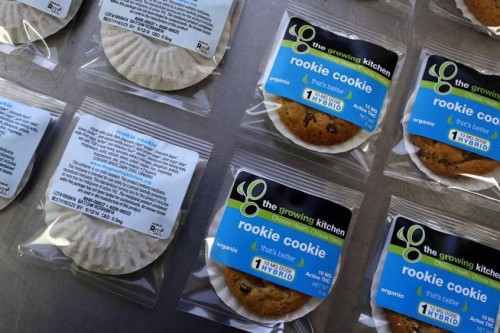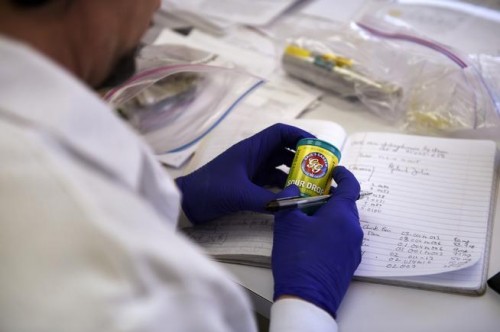… continued from the first page
“It’s basically the same with these edibles,” he says. “They’re extracted from essentially low-quality material but purified to a high level in order to make something good out of it. There is no question that different varieties of these plants contain different secondary compounds, and if you’re able to preserve those characteristics all the way through, you’re going to have more of the same effect as if you’d consumed that plant directly (through smoked flower).”
There is also the issue of how the trim is moved from the grower to the edible manufacturer, and how long it waits before being put through the extraction process.
“If it’s too wet you’re going to get mold, and if it’s too dry and sits there the THC slowly converts to CBN, which is going to be different,” says recent Ph.D. graduate Lynch.
Brooke Wise owns The Growing Kitchen, and she says she used to buy trim from other cultivators. But then she learned that the trim would often sit on the shelf for extended periods of time — allowing it to break down and degrade. And then she started finding “dog hair and rubber bands” mixed into the trim, which was at times found to be moldy.
That’s when she decided to grow her own cannabis and only use the marijuana flower for her recipes — never the trim.
“If anyone tries to tell you that trim is the same thing as the plant, you can look that up yourself: It’s not the same,” says Wise. “The cannabinoids that are rich and dense in the flower buds are clearly not the same. CBN is more readily available in the trim and sugar leaves than it is in the flower buds, which makes sense that some products make you anxious or paranoid, if you’re just stripping out the THC and you’re not given the opportunity to get the whole-plant experience. Other elements balance out the THC and keep you from getting too paranoid.
“You can’t take it apart and expect to have the same quality experience.”
Wise says that she’s heard complaints from customers about her products being stronger than advertised, but she explains that this is because these customers have become accustomed to eating someone else’s low-quality 80-milligram product — and when when they eat her 20-milligram product it’s too much. This, she asserts, is due to the purity of her cannabis and the interactions of it with specific food ingredients.
While purchasing trim wholesale remains the predominant method of manufacturing, the overwhelming popularity of edibles has often left companies scrambling to find enough trim to satisfy public demand, which has made growing your own an attracting option for manufacturers.
“Purchasing trim is not necessarily a cheaper option in my opinion,” says Torrin Panico, who recently founded Craft, a Colorado-based extracts and concentrates company. “The initial cost of a garden is more expensive, yes, but the value you receive from producing edibles with your own, whole plant-extracted oil, or even your own trim, is gonna be way more effective than any trim you find on the market.
“This is because no one is going to sell their premium trim to you as an edible company these days, and if they do you will overpay because of the demand for concentrates in the market. Typically, as a wholesale trim purchaser, you are only left with options of using poor trim, machine trim, fan leaf or stuff that is riddled with PM (powdery mildew) or mites, which results in very poor-tasting oil and also not a very high-THC or -CBD count. You are at the mercy of all the different growers, resulting in different quality, which affects the outcome of your final product’s taste and potency, leaving you with no true consistency.”
Karin Lazarus, founder of Sweet Mary Jane, says that they’ve been purchasing their cannabis material wholesale for five years but have recently established their own garden.
“The prices for cannabis have fluctuated so much over the years, which has made it hard to figure our costs from one month to the next,” says Lazarus. “We now have our own grow, however we have not had our first harvest, so I really can’t say (what the cost/benefit will be). I will be able to within the next few months when we do our take down.”
4. The type of food in your edibles can be as important as the type of cannabis

“A lot of these edible companies are working with people who know a lot about cannabis, but aren’t necessarily chefs,” says Panico, a chef with 15 years experience who worked with The Growing Kitchen before starting Craft. “Knowing how to cook plays a large part in your final product; You need to understand the science of food, along with the science of cannabis, to be able to bring them together to make products that work for everyone.”
The Growing Kitchen’s Wise admits that the scientific data showing exactly how the type of food in an edible interacts with the cannabis is “probably 10 or 15 years” into the future but adds that “cannabis acts as a catalyst with other herbs, making (the infused foods) significantly more powerful than any of those things by themselves,” she says. “It’s like how if you consume olive oil with tomatoes it helps your body absorb the nutrients, as opposed to if you were to consume those two things separately. When you mix omega oils and agave nectar and cannabis, the end result is incredibly different. We use spirulina — which is a blue-green algae that is incredible for energy and improving your mood — with our ‘Zoom Balls.'”
For some athletes, edible marijuana has become a popular aid to increase energy, focus and mood when working out. Naturally, not just any edible will do for this; You would not only need to find a product made with a type of cannabis that won’t put you into a state of couch-lock but also something that is mixed with a type of food that won’t drag you down.
“If you want to go workout you can mix the sativa oil into a trail-mix bar that helps to stimulate that part of your body, and then the sativa will carry it through,” says Panico. “With edibles it’s all about the carriers that go along with it. If you have an edible that’s really heavy with dense chocolate, like a brownie, even if you make it sativa, your body naturally is going to get more tired, because of how dense it is, than if you were eating something packed with nuts and honey.”
CU-Boulder’s Lynch adds: “There’s no question that your body takes longer to digest foods that are high in fat. The more food you eat, the more fiber and fat it contains, the longer it’s going to take to make it through your small intestine. But at this point we don’t even understand the plant itself completely, so when it comes to the interactions with all the other food in an edible, there isn’t a whole lot to go on right now.”
5. The science behind edibles is a generation behind flower

Throughout the number of interviews we conducted with scientists for this story, the most common response to the questions we asked was, “We don’t know that yet.” This wasn’t due to a lack of interest or curiosity; the scientific research on cannabis is still very restricted, and the idea of a public health crisis surrounding edible marijuana products was something few people saw coming.
“The rise of popularity of edibles is so recent, there’s been a limited amount of research I’ve seen on the metabolism of THC in edibles versus inhaled marijuana,” says Kane. “Most of what I’ve seen on the subject hasn’t even been published yet. Most of the industry is relying on anecdotal evidence. I’m sure a lot of the claims people are making are based on something, but it could be something flimsy or something substantial. People have been experimenting with marijuana formally and informally for a millennium, but in terms of rigorous scientific study, not a lot has been done.”
Clearly, there is a long road to be traveled before a budtender can point to a display of treats and confidently say, “You can take this one for energy” or “Take that one to calm you down.” Even the amount of THC has become difficult to nail down, as testing methods vary from lab to lab. It’s possible that we may even be overestimating the significance of THC in whether an edible turns you into a zen-like Tommy Chong or a clawing-at-your-skin Maureen Dowd.
“The bottom line is that we know next to nothing about cannabis as it pertains to consumption and regulation in Colorado,” says Hutchison. “This is due in large part to our inability to conduct scientific studies on cannabis that is grown here in Colorado. Even with the bill that was introduced in Congress recently, research will still be limited to cannabis grown at the government facility in Mississippi. Until someone finds a way for scientists to conduct research on cannabis grown in Colorado and edibles made in Colorado, we are flying blind. In my mind, that fact is a huge disservice to the people of our state.”
In the years to come, we will surely see more published studies on how extracts work and how different they are from flower — not to mention the impact of extraction methods, the type of plant material used and the types of foods being infused.
Will we then be able to predict an edible’s effect on our bodies and minds? Time will tell.
It’s safe to say, the industry will only change if public demand moves it that way. So ask your budtender for some background information on the products you’re looking at. Does the manufacturer grow their own cannabis? Is this product made from trim or flower — and what kind of plant did it come from? What type of food is in the edible? Be specific about what type of effect you’re looking for, whether it be for pain management, creative energy or help with sleep.
And if your budtender answers, “I don’t know,” don’t give him or her a hard time about it. Because when it comes to edibles in the first half of 2015, there are plenty of “I don’t knows” to go around.
